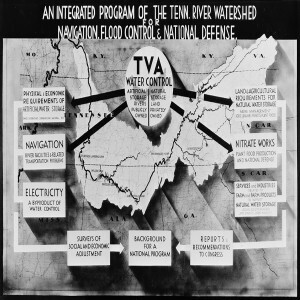
On this day in labor history, the year was 1933.
That was the day President Franklin Roosevelt signed the Tennessee Valley Authority Act.
The act created the TVA as a federal corporation and was tasked to address the resource development of the region, one of the poorest in the United States.
These included flood control and improved travel along the Tennessee River.
It also meant improved forestry to address soil erosion and facilitation of agricultural production.
Control of water resources required a series of dams, designed to navigate the river and reduce flooding.
Though Wilson Dam had been completed before the establishment of the TVA, the authority had embarked on the construction of sixteen more dams.
During the Depression, the TVA hired tens of thousands of workers for conservation, construction and development.
Historian Erik Loomis notes that though the TVA was one of the region’s largest employers of black workers, the authority also maintained rigid lines of segregation in its workforce.
He adds that though 14 AFL unions eventually worked on dam construction, the agency initially refused to recognize unions.
Workers would wait until 1940 to sign first contacts in the anti-union South.
Today the authority is most well known for its supply of electricity to nearby communities.
It is the nation’s largest public power company and serves about 80,000 square miles in the southeastern United States.
TVA capacity to generate electric power includes some 29 hydroelectric dams, 11 coal fired plants, 3 nuclear plants and several combustion-turbine installations.
It also has several solar and wind installations.
The authority produces more than 130 billion kilowatt-hours of electricity each year.
The TVA played a critical role in transforming the South by constructing infrastructure necessary for modernization and industrialization.
More Episodes
 2024-09-10
2024-09-10
 2024-09-09
2024-09-09
 2024-09-07
2024-09-07
 2024-09-06
2024-09-06
 2024-09-06
2024-09-06
 2024-09-05
2024-09-05
 2024-08-30
2024-08-30
 2024-08-28
2024-08-28
 2024-08-27
2024-08-27
 2024-08-26
2024-08-26
 2024-08-25
2024-08-25
Create your
podcast in
minutes
- Full-featured podcast site
- Unlimited storage and bandwidth
- Comprehensive podcast stats
- Distribute to Apple Podcasts, Spotify, and more
- Make money with your podcast
It is Free
- Privacy Policy
- Cookie Policy
- Terms of Use
- Consent Preferences
- Copyright © 2015-2024 Podbean.com




